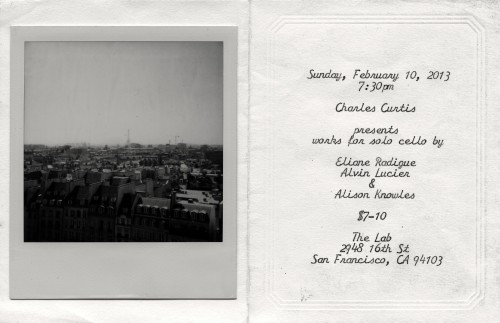Charles Curtis solo cello works by Eliane Radigue & Alvin Lucier – Feb. 10th – The Lab, SF

Charles Curtis at The Lab, San Francisco
Sunday, February 10, 2013, 7:30pm
In a two-part concert, cellist Charles Curtis will present solo works created for and with him by Éliane Radigue, Alvin Lucier and Alison Knowles. Radigue’s Naldjorlak (2005) is a nearly hour-long, continuous exploration of the acoustical properties of the cello, centered around a tuning of the cello to its own intrinsic resonance. All of the strings are brought into alignment with the cello’s “wolf tone”; the entire corpus of the cello is engaged to elicit a complex, closely related spectrum of harmonics and resonances. Lucier’s Slices for Cello and Pre-recorded Orchestra (2011) sets the solo cello against a sustained chromatic tone cluster in 52 orchestral instruments, arrayed as a Supercollider patch. By outlining the cluster in various melodic orderings, the solo cello erases and re-inscribes the orchestral cluster in a slowly unfolding process. Alison Knowles’ Rice and Beans for Charles Curtis (2008) is a graphic score made of hand made rice paper, beans, lentils and bits of fabric and string. Curtis interprets this work of visual art in a performance analogous to the making of the score, working over the “score” of the instrument in several passes, seeking out unsuspected resonances by tapping, rubbing and stroking the instrument with bare hands.
Éliane Radigue (born 1932) is one of the pioneers of electronic music and music of long duration. Naldjorlak is her very first work for an acoustic instrument.
Alvin Lucier (born 1931) is an American experimental composer who directly engages the physical properties of sound in space. Works of his such as “I am sitting in a room” and “Music for Solo Performer” are landmarks of late twentieth-century art.
Alison Knowles (born 1933) is a first generation member of Fluxus and an internationally acclaimed visual artist, poet and musician. Her work elaborates John Cage’s ideas of indeterminacy in rigorous and surprising new applications.